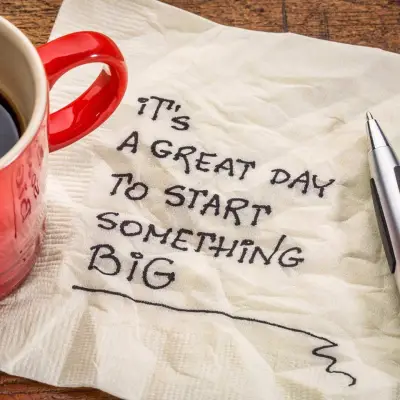Do you ever feel like your big dreams for life are stuck in your head rather than happening in real life? Creative visualisation could be the key to manifesting your goals - it taps into the power of your imagination to make your visions of the future feel real and within reach. So what exactly is creative visualisation, and how can it help you to turn your aspirations into reality?
Jump to:

What is Creative Visualisation?
Creative visualisation is all about harnessing your imagination to envision the life you want. The idea is that your mind can actually help you to shape your reality if you feed it with the right images. When you take the time to intentionally see and feel your future successes, you plant the seeds that can make them a reality.
It has 3 core principles:
- Clarity - The clearer and more detailed your mental images, the more effective the visualisation.
- Emotion - Feeling your visualisations with strong positive emotions increases their impact.
- Belief - A deep-seated belief in the possibility of achieving your goals is essential.
The concept of creative visualisation is rooted in the idea that the mind and body are interconnected. When you vividly imagine a desired outcome, your brain activates the same neural pathways and processes as if you were actually experiencing it. This process triggers physiological responses that align with your mental imagery, reinforcing the mind-body connection.
By consistently visualising your desired dreams and outcomes, you can:
- Clarify your goals - Visualisation helps you to define your goals with precision, allowing you to identify what you truly desire.
- Boost Motivation: Vivid mental imagery stirs emotions and motivates you to take action towards your goals.
- Overcome Obstacles: Visualisation can help you to anticipate and mentally prepare for challenges, increasing your ability to overcome them.
- Grow Confidence: Repeatedly visualising success builds self-confidence and a strong belief in your capabilities.
- Attract Opportunities: The positive energy that’s generated by creative visualisation can draw opportunities and resources into your life.
- Better Focus: Visualisation sharpens your focus, helping you to maintain clarity and persistence when pursuing your dreams.
Recommended for you!
Best SellersThe Science Behind Creative Visualisation
Creative visualisation has a solid foundation in both psychology and neuroscience. Psychologically, it draws from the principles of cognitive psychology and positive psychology. Cognitive psychology emphasises how mental processes like perception, memory, and imagination influence behaviour and decision-making. Positive psychology explores the role of optimism, positive emotions, and self-efficacy in enhancing well-being and achievement.
Neurologically, creative visualisation operates on the premise that the brain cannot tell the difference between real experiences and vividly imagined ones. As mentioned earlier, when you engage in creative visualisation, your brain activates the same neural pathways and regions as if you were physically experiencing the situation. This activates the release of hormones and neurotransmitters that are linked to the emotions you're imagining. So, if you visualise success, your brain will chemically respond by producing compounds that are associated with accomplishment, confidence, and motivation. The effect on your nervous system is real, even if the scenario is just in your mind - that’s why creative visualisation can be so powerful!
Its Impact on Motivation
Neurotransmitters (such as dopamine) that are released during your creative visualisation process are associated with pleasure and reward. As a result, your motivation increases as your brain associates the goal with positive emotions and outcomes.
Furthermore, the brain's reticular activating system (RAS) plays a crucial role in this process. The RAS acts as a filter for information, prioritising stimuli that align with your goals and beliefs. Through creative visualisation, you program your RAS to notice opportunities and resources that are in line with your visualised goals. This heightened awareness can lead to increased motivation and behavioural changes.
Creative Visualisation is not only used at home but also in sports psychology, business, psychiatry and more. For example, athletes frequently use visualisation techniques to enhance performance. Studies have shown that mentally rehearsing sports skills can lead to improved physical performance and greater confidence. Additionally, in Psychiatry, visualisation is used for pain management, as studies have shown that it can actually reduce pain perception in patients.

Techniques for Creative Visualisation
To begin your journey into creative visualisation, start by finding a quiet, comfortable space. Close your eyes and take a few deep breaths to relax. Then, create a vivid mental image of your desired goal or outcome. Visualise it as if it's happening right now, engaging all your senses. Pay attention to details, emotions, and the environment to make the visualisation as real as possible.
As you do this, you can use any of the following visualisation techniques:
Guided Visualisation
With guided visualisation, you use audio recordings or scripts to walk you through the visualisation process step-by-step. These guides provide prompts and descriptions that help you to imagine a detailed scene and fully immerse yourself in the experience. You can find guided visualisations that are tailored to different goals like relaxing, personal development, or accomplishing your dreams. This extra guidance can be really helpful if you're new to visualisation or need some extra structure. Having a voice that leads you through the imagery keeps you focused with cues that can help you engage all your senses and emotions to create a vivid mental image.
Affirmations
Affirmations are positive statements that you repeat to yourself that align with your desired outcomes. For example, if you are visualising success in your career, you could use affirmations like "I am confident and capable in my profession." The purpose is to reinforce your belief in your abilities so that you achieve what you envision. As you vividly imagine your goals being reached, the affirmative statements strengthen that vision of future success and programme your mind to manifest your dreams into reality.
Relaxation
It's important to calm and focus your mind before visualising so you can fully immerse yourself in the experience. Meditation and relaxation techniques can help you to tap into a receptive mental state. Try taking some deep breaths, tensing and relaxing each muscle group, or practising mindfulness meditation. Relaxation quietens mental noise so that you can give your complete attention to the sights, sounds, and feelings of your mental vision.
Bringing your biggest visions to life starts with the power of your imagination. If you're ready to turn your dreams into reality, check out our accredited Creative Visualisation Diploma Course for just £37 (save £110!). It will offer step-by-step guidance as you seek to manifest your goals through the art of visualisation.













